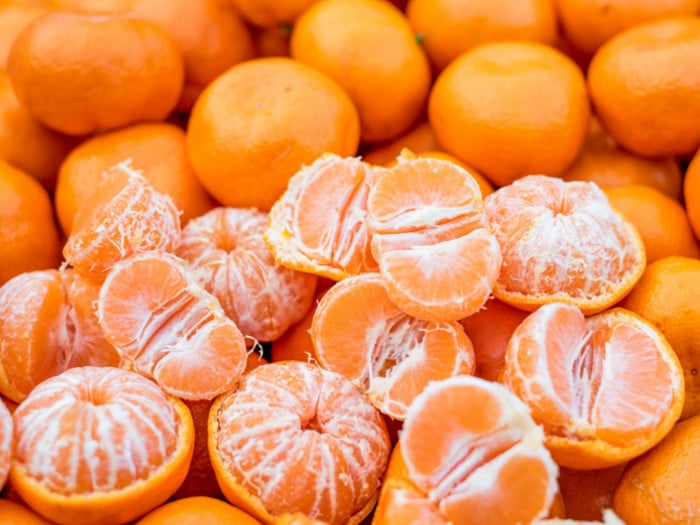Miniature mandarin orange may not look like an impressive fruit, but it packs a powerful nutritional punch.
What is Mandarin Orange?
Tiny mandarin orange is a sweet type of orange that grows no larger than 8 centimeters in size. It contains more sugar than most other citrus varieties, making it particularly popular for desserts and as a children’s snack. Mandarins are a traditional gift for the Chinese New Year and Christmas and can be found in a variety of recipes, from salads to fruitcakes. Mandarin orange is also used in both Chinese traditional and Ayurvedic medicine.
Varieties
There are many varieties of mandarin orange, including pure mandarins, non-pure mandarins, mandarin cross, Mangshanyegan, clementines, tangerines, and Satsuma among others. Let us take a look at them in detail below.
- Pure Mandarins: Pure mandarins are heirloom varieties like Tachibana and Nanfengmiju that have stayed close to the original Asian mandarin strains.
- Non-pure Mandarins: These are varieties that are slightly mixed with other citrus fruit, most commonly pomelo, but retain mostly mandarin distinctions. Satsumas, tangerines, and murcotts are all non-pure mandarins.
- Mandarin Cross: Mandarin crosses are hybridized varieties where the Mandarin has been equally mixed with another citrus to produce commonly known fruits, such as Meyer lemons and grapefruit. Clementines are a mandarin cross with sweet oranges, for example.
- Mangshanyegan: This is a type of citrus fruit, native to China, that is classified as a non-mandarin. Despite the similarities, mangshanyegans are actually a completely separate species of citrus.
- Clementine: These are bred from Mediterranean mandarin strains. They are the smallest mandarin variety, very sweet, and seedless. Most clementines are imported from Europe.
- Tangerine: Tangerines and mandarins are often used interchangeably as names, but while all tangerines are mandarins, not all mandarins are tangerines. Tangerines have a tougher skin and taste more akin to a regular orange, with less sweetness and more of a citric bite.
- Satsuma: Satsuma is a type of fruit, originating in Japan, which is a mandarin-pomelo hybrid. Satsumas may be a bit larger than a pure mandarin but retain same loose skin. They are grown in Asia and the Southern United States.

Delicious Mandarin oranges Photo Credit: Shutterstock
Serving Size : Nutrient Value Water [g] 85.17 Energy 53 Energy [kJ] 223 Protein [g] 0.81 Total lipid (fat) [g] 0.31 Ash [g] 0.38 Carbohydrate, by difference [g] 13.34 Fiber, total dietary [g] 1.8 Sugars, total including NLEA [g] 10.58 Sucrose [g] 6.05 Glucose (dextrose) [g] 2.13 Fructose [g] 2.4 Calcium, Ca [mg] 37 Iron, Fe [mg] 0.15 Magnesium, Mg [mg] 12 Phosphorus, P [mg] 20 Potassium, K [mg] 166 Sodium, Na [mg] 2 Zinc, Zn [mg] 0.07 Copper, Cu [mg] 0.04 Manganese, Mn [mg] 0.04 Selenium, Se [µg] 0.1 Vitamin C, total ascorbic acid [mg] 26.7 Thiamin [mg] 0.06 Riboflavin [mg] 0.04 Niacin [mg] 0.38 Pantothenic acid [mg] 0.22 Vitamin B-6 [mg] 0.08 Folate, total [µg] 16 Folate, food [µg] 16 Folate, DFE [µg] 16 Choline, total [mg] 10.2 Betaine [mg] 0.1 Vitamin A, RAE [µg] 34 Carotene, beta [µg] 155 Carotene, alpha [µg] 101 Cryptoxanthin, beta [µg] 407 Vitamin A, IU [IU] 681 Lutein + zeaxanthin [µg] 138 Vitamin E (alpha-tocopherol) [mg] 0.2 Tocotrienol, alpha [mg] 0.05 Fatty acids, total saturated [g] 0.04 14:0 [g] 0 16:0 [g] 0.04 18:0 [g] 0 Fatty acids, total monounsaturated [g] 0.06 16:1 [g] 0.01 18:1 [g] 0.05 Fatty acids, total polyunsaturated [g] 0.07 18:2 [g] 0.05 18:3 [g] 0.02 Tryptophan [g] 0 Threonine [g] 0.02 Isoleucine [g] 0.02 Leucine [g] 0.03 Lysine [g] 0.03 Methionine [g] 0 Cystine [g] 0 Phenylalanine [g] 0.02 Tyrosine [g] 0.02 Valine [g] 0.02 Arginine [g] 0.07 Histidine [g] 0.01 Alanine [g] 0.03 Aspartic acid [g] 0.13 Glutamic acid [g] 0.06 Glycine [g] 0.02 Proline [g] 0.07 Serine [g] 0.03 Sources include : USDA [1]
Mandarin Orange Nutrition
One medium mandarin orange contains 47 calories, with 9 grams of sugar and 12 grams of carbs. It also has nearly 40% of the recommended daily dose of vitamin C and 11% of the daily recommended vitamin A. [2]
Benefits of Mandarin Oranges
Mandarin oranges are an excellent source of vitamin C, which helps promote collagen production in the body. They also contain synephrine, which is a bronchial dilator and is a rich source of fiber. The presence of flavonoids and other antioxidants also contribute to its amazing benefits. Let us look at the benefits of mandarin orange below. [3] [4]
- Boosts immunity
- Fights off free radicals
- Prevents cell damage
- Improves skin health
- Strengthens hair
- Fights allergies
- Gives relief from cold
- Suppresses appetite
- Aids in weight loss
- Supports digestive health
- Regulates cholesterol levels
- Lowers blood pressure
- Helps manage diabetes [5]
- Anticancer potential
Mandarin Orange vs Clementine vs Tangerine vs Orange
Orange
Orange is a large citrus fruit, second in size to grapefruits, with a tart, acidic flavor, and is most popular for juicing. [6]
Mandarin Orange
Mandarin orange is a category of oranges, smaller in size and very sweet, with loose skin. Clementines and tangerines are both types of mandarins.
Clementines
Clementines are the smallest type of mandarin. They are very sweet, seedless, and the most commercially popular mandarin variety.
Tangerines
Tangerines are a deep red type of mandarin and are named for the port of Tangiers where they were first imported. The fruit is bigger and slightly more tart than mandarin oranges.
